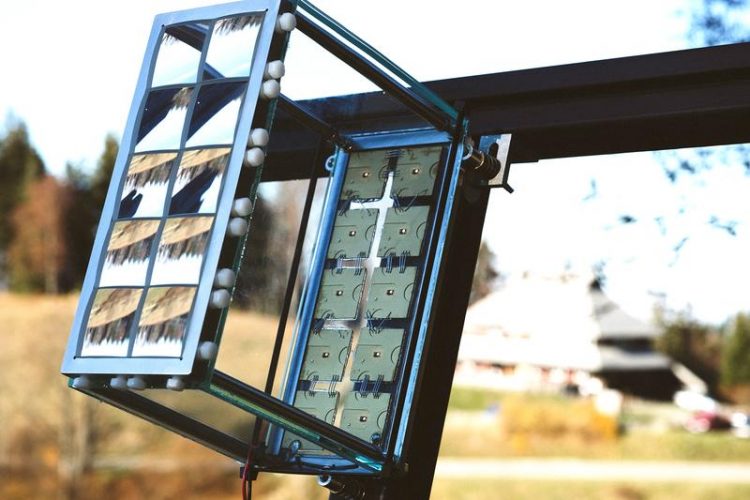Concentrator Photovoltaics Shows Peak Performance – Module Efficiency Reaches 41.4 %

High-Concentration Photovoltaic (HCPV) Module with record high efficiency. 41.4% of the direct solar irradiation is converted into electricity. © Fraunhofer ISE/Alexander Wekkeli
High-concentration photovoltaic (HCPV) systems offer renewable electricity with the highest conversion efficiency and thus a correspondingly low use of resources especially in regions with high direct normal irradiance.
In this technology multi-junction solar cells, based on III-V compound semiconductors, are used. In these solar cells, several thin subcells are stacked on top of each other in order to convert the solar irradiance more efficiently. Optical lenses concentrate the incoming sunlight onto the miniature sized solar cells. The modules are mounted on a two-axis tracking system that follows the sun’s path during the day.
The industrial implementation of highest efficiencies for concentrator PV modules and thus the reduction of the gap between research results and industry production were the focus of the CPVMatch project. Headed by Fraunhofer ISE, a consortium of research institutes and industry partners from Germany, Italy, Spain and France have worked on new solutions over the past 3.5 years to this end.
“In CPVMatch, we have addressed all production steps for concentrator modules starting from the materials, through cell fabrication and production systems, and up to the challenges facing module manufacturing,” reports Dr. Gerald Siefer, project head and group leader of III-V Cell and Module Characterization at Fraunhofer ISE.
The project partners have achieved two major results: By using innovative cell architectures for multi-junction solar cells with new materials, processes and manufacturing equipment, the researchers were able to optimize the production of four-junction solar cells.
Also, they were able to improve the design of high-concentration modules, primarily by modifying the optics and making use of achromatic lenses. The combination of four-junction solar cells with achromatic lenses has led to the new record efficiency of 41.4 percent for a 122 cm² module.
“We are extremely pleased about these results that pave the way for further efficiency increases in the concentrator technology,” says Dr. Andreas Bett, institute director of Fraunhofer ISE. “Photovoltaics is booming worldwide, and we see great potential for this particularly efficient module technology.
It significantly decreases the use of resources for energy conversion per unit area and thus contributes to more sustainability.”
https://www.ise.fraunhofer.de/en/press-media/press-releases/2018/concentrator-ph…
Media Contact
All latest news from the category: Power and Electrical Engineering
This topic covers issues related to energy generation, conversion, transportation and consumption and how the industry is addressing the challenge of energy efficiency in general.
innovations-report provides in-depth and informative reports and articles on subjects ranging from wind energy, fuel cell technology, solar energy, geothermal energy, petroleum, gas, nuclear engineering, alternative energy and energy efficiency to fusion, hydrogen and superconductor technologies.
Newest articles

A universal framework for spatial biology
SpatialData is a freely accessible tool to unify and integrate data from different omics technologies accounting for spatial information, which can provide holistic insights into health and disease. Biological processes…

How complex biological processes arise
A $20 million grant from the U.S. National Science Foundation (NSF) will support the establishment and operation of the National Synthesis Center for Emergence in the Molecular and Cellular Sciences (NCEMS) at…

Airborne single-photon lidar system achieves high-resolution 3D imaging
Compact, low-power system opens doors for photon-efficient drone and satellite-based environmental monitoring and mapping. Researchers have developed a compact and lightweight single-photon airborne lidar system that can acquire high-resolution 3D…





















